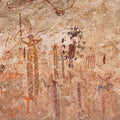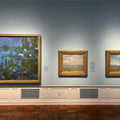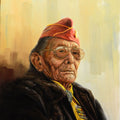Eric-Paul Riege 'Earrings for the Big Gods'
By Chadd Scott on
If you can make it there, you can make it anywhere. Good news for Eric-Paul Riege (b. 1994, Na’nízhoozhí/Gallup, NM; Diné) whose first solo institutional exhibition in New York can be seen at Canal Projects in Tribeca now through March 29, 2025.
Even before receiving validation from the Big Apple, Riege has been “making it,” establishing himself in the last couple years as one of the most in-demand contemporary Native American artists. He had an exhibition at the prestigious Hammer Museum in Los Angeles in 2023, the same year the National Gallery of Art acquired one of his pieces. His artwork is highlighted in the Montclair Art Museum’s (Montclair, NJ) reinstallation of its Native American art galleries, a project debuted in 2024 featuring Riege alongside Nicholas Galanin, Jeffrey Gibson, Cara Romero, Rose B. Simpson, and Kay WalkingStick among other giants of contemporary Native art.
In New York, the artist presents “iiZiiT [3]: RIEGE Jewelry + Supply,” a multilayered installation of new textile, sculpture, performance, and video works, with Riege examining the legacy of pawn shops and trading posts across the Southwest like those he grew up around.
“This show, I wanted to give the feeling of walking into (a trading post), that overwhelming sense when you walk in – it’s so beautiful,” Riege said.

Eric-Paul Riege Canal Projects installation view with video.
That beauty, however, often comes with a literal and figurative cost.
“There's so many (trading posts) in Gallup, and to my knowledge, there's still only one Native owned jewelry and trade shop in Gallup. There’s this sense of history and ancestry that I'm lucky to be enveloped in, but at the same time, our economy is run at the expense of the artists themselves,” Riege explained. “Oftentimes, people who make jewelry will go into these spaces, their (artwork is) sold (to dealers) for less than what they're actually valued, and then tripled the price (retail), and then to tourists coming through, (marked) 20% off.”
By referencing traditional trading post goods like jewelry, Riege grapples with presumed notions of cultural authenticity and agency. While significant to Native art markets and livelihoods, historical pawn shops and trading posts have also facilitated centuries of unethical and coercive trading practices between colonizers and Indigenous peoples. Today, modern trading posts continue buying and selling Native goods, often catering to tourists and offering wares divorced from their original context and creators.
Riege is also troubled by how those same tourists who “ohh” and “ahh” over jewelry for sale at the trading post respond to the artists outside of the shop.
“When you go to a restaurant in Gallup, it's common for these same (artists) to come table to table to table (selling jewelry), but then you read Yelp reviews or Google reviews of restaurants and people will say they're being bothered by people selling table to table while they’re eating,” Riege said. “The person who you are now dismissing in this circumstance, under the glass case next door, the idea of them is revered because there's no longer a face to the object, you don't have the maker's hands or body connected to it, it's being sold to you by someone who's an expert, I guess, and the value exchange there is a complicated one.”
Material culture, value, authenticity, these are all topics Riege explores in the exhibition. Not only in Gallup, but riffing on the economy of counterfeit merchandise and knockoff luxury handbags and watches prevalent on Canal Street, where Canal Projects is located.
“Izit is a slang term on the Navajo Reservation,” Reige said. “Like, ‘Oh, is it?!,’ but it can be another idiom for authenticity. Is it real? Is it fake?”
“iiZiiT [3]” for the exhibition title as this is the third iteration of Reige playing with these notions of material authenticity.

Eric-Paul Riege Canal Projects installation view.
Earrings for the Big Gods
“iiZiiT [3]: RIEGE Jewelry + Supply” features the artist’s signature soft woven sculptures, evoking the jewelry worn by “Holy People”—Diné giants who roamed the Earth before humans. Titled jaatloh4Ye’iitsoh, or Earrings for the Big Gods, these monumental felted necklaces earrings – totems of memory – honor the artist’s matrilineal heritage of weavers, especially the protective deity Na'ashjé'ii Asdzáá (Spider Woman) who introduced early Diné people to the art of weaving.
“Earrings, like our weavings, and our silver jewelry making, are forms of protection. Our holy people can identify us through that,” Riege explained. “When they're scanning over the world, that's how you're protected, and they can follow you. One of my grandmothers told me that your earrings and your rings listen and feel just as much as you do. That's the idea of tactile memory. When you put on a sweater that you wore, you remember the last time you wore it, and who you were with, and the conversations.”
Riege’s grandmother further taught him that wearing jewelry amplifies the senses. Earrings can hear what we miss and necklaces placed close to the heart help us feel emotions more deeply.
A pair of Riege’s Jaatłoh4Ye’iitsoh feature prominently in a large scale exhibition of Native American art presently on view at the Denver Art Museum.
Jaatloh4Ye’iitsoh. In Diné, jaa is your ear lobe, tłoh, a thread artists wove through jewelry pieces before the Diné had silver, “4” is the English word “for,” and Ye’iitsoh means big god.
“Those are one of our holy figures/monsters that wandered the earth before we did,” Riege said. “If they are looking out for us with jewelry, then they knew what it looked like, so they wore it. That's why I make jewelry for the big gods, as a way of animating those stories. Also putting yourself in the scale; if the earring is 19-feet-tall, then the ear of the giant is maybe another 19-feet-tall, and then the head’s the size of this building – playing with scale and imagination.”
In the Canal Projects show, Riege is playing on a different scale. A much shorter scale. When first shown the gallery occupying a historic building, he chose a basement space below street level with low ceilings and exposed water pipes for the presentation.
“I’ve never worked with such short ceilings before, and I felt like this could give reference to the pawn and trade shop where you go in and its chaotic in the most beautiful ways, where there’s just so much material and weavings, and it’s like entering this womb,” he said.
Riege’s soft sculptures are hung from the ceiling in a pattern inspired by a spider or squash blossom – octagonal. The installation also references a hooghan – the traditional Diné dwelling – contemporary versions have eight sides, like the spider has eight legs, another homage to Spider Woman.
“Being a guest here, this is not my home, but I wanted to bring things from home, and I feel like the best way sometimes for me to do that is to create a homelike structure,” Riege said. “Thank you for welcoming me Lenapehoking to this place, and I’m hopefully welcoming you into my home in some way.”
Lenapehoking is the homeland of the Lenape people, of which New York City is part.

Eric-Paul Riege Canal Projects performance.
Still, not Static
Reige’s textile sculptures will be activated at Canal Projects via a performance during the closing of the exhibition.
“I perform with all of these objects,” Riege said. “I consider them all wearable in some sort of way, whether that’s me actually putting it on my body like the video, or (when they’re installed) during the performance, I might wrap (them) around my neck.”
“iiZiiT [3]: RIEGE Jewelry + Supply” includes a large video showing Riege dancing his soft sculptures.
Riege gave an hour-long performance for the exhibition’s opening, and for the closing, expects to perform three or four hours
“The longest performance I’ve ever done was eight hours,” Riege said. There’s that number again. “I come from weavers and when I first learned how to weave, that testing and patience of working for hours and hours (was important) and there’s so much growth on the loom. There’s a meticulousness to it. When I started doing performance, that was one of the things that was important to me, to give honor to coming from weavers and the time spent at the loom.”
His performances serve another purpose, providing a different way to look at his artworks, and ourselves.
“I wanted to show viewers that these objects have many different forms,” Riege said. “I always say they’re not static, they’re just still. Like us when we go to bed, we’re still.”
A date and time for Riege’s closing performance has not yet to be set. Contact the gallery for updates.



